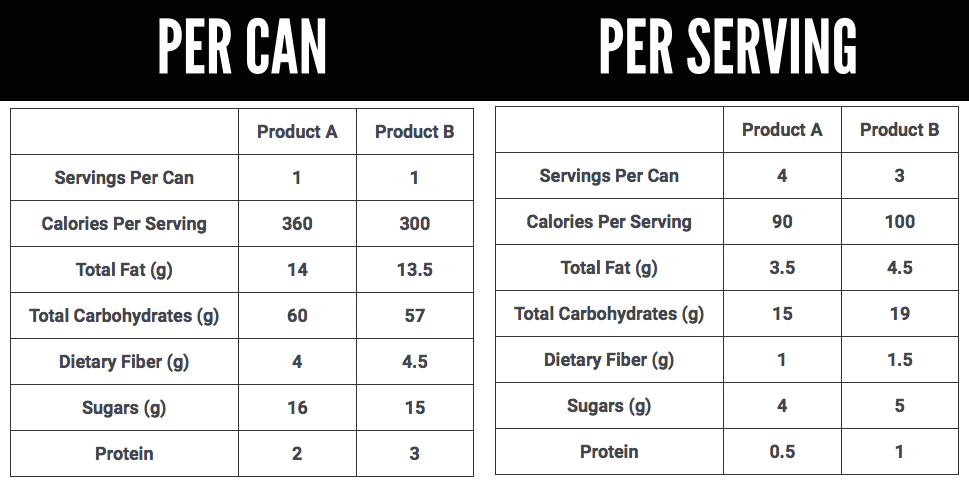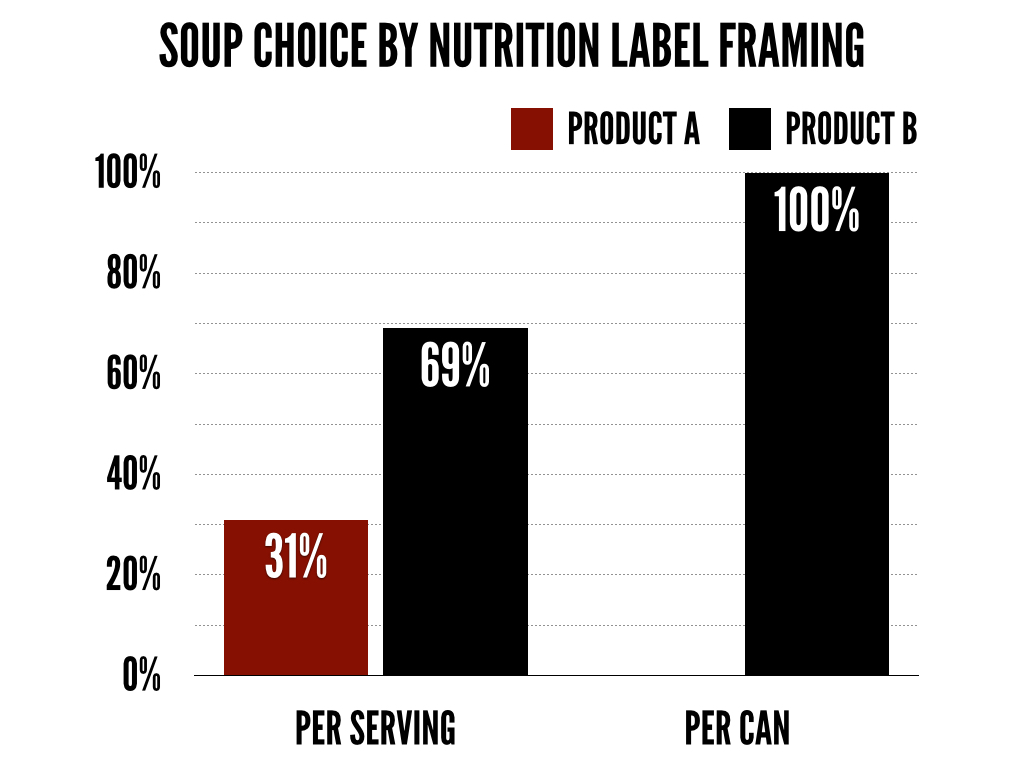All of my #1QFriday questions thus far have focused on a numerical response. How few miles is it from Eugene, OR to Philadelphia, PA? What percentage of 40-yard field goals does the average college kicker make? All of them required some sort of numerical estimate. This week’s question switched to choice. Specifically, the task was to choose between two cans of soup:
Assuming you plan to eat the entire can of soup by yourself for dinner, which soup do you think is the healthiest choice?
The question remained the same in all conditions but there were two variations of the nutrition information (see below). One showed the nutrition information by serving (as we typically see with cans of soup) while the other showed the nutrition information by can (as if you were going to eat the whole can like a normal person).

This idea was inspired by glancing at a few nutrition labels on canned goods and realizing that the perception of health can change due to the multiplier effect of servings per can. Consider the differences in the two options:
Product A: 4 servings per can | 90 calories per serving
Product B: 3 servings per can | 100 calories per serving
Ignoring what calories/ingredients are healthy, a quick look at this suggests Product A is healthier because 90 calories is less than 100 calories. But what if you actually do the math on a per can basis?
Product A: 4 servings per can x 90 calories per serving = 360 calories
Product B: 3 servings per can x 100 calories per serving = 300 calories
What happened? Product A had 4 servings per can while Product B had 3 servings. Thus, when they’re multiplied out, the health perceptions could/should reverse.
Who picks up a can of soup and thinks “I think I’ll only have 1/4 of this and save the rest for tomorrow.”!?!? NOBODY. Therein lies the problem. People are buying based on PER SERVING perceptions but actually eating the PER CAN information.
So let’s see if/how the framing of nutrition information actually influences choice…

What do you notice?
Preferences changed. A lot. 31% of people in the per serving condition thought Product A was the healthier choice. How many people thought Product A was healthier in the per can condition? ZERO. Not one person. What does this mean? Clearly, the framing of the nutrition information has the potential to drastically influence choice.
What might play a role?
Effort/Motivation. This could come in two forms. First, the people responding might have had zero interest in the survey, and thus didn’t really pay attention, read the question closely, etc. Or, more likely, we have developed mental shortcuts (known as heuristics) to process nutrition labels. Thus, we tend to avoid doing the math required (i.e. multiplying per serving information by the number of servings) and end up failing to identify the healthier option.
So what is the takeaway?
We (likely) have a huge issue with how nutritional information is presented and processed. I am not a nutritionist, nor a health expert, but I spend a lot of time researching how messages are framed. And framing of messages that influence health behaviors shouldn’t be taken lightly. Recently, the FDA proposed new nutrition labels:

Beyond changes to the actual label above, this change will likely make a big difference:
“Require that packaged foods, including drinks, that are typically eaten in one sitting be labeled as a single serving and that calorie and nutrient information be declared for the entire package. For example, a 20-ounce bottle of soda, typically consumed in a single sitting, would be labeled as one serving rather than as more than one serving.”
In other words, a can of soup would presumably be labeled on a per can basis (as opposed to a per serving framing). We’ll see how it plays out. There is a fair amount of wiggle room in terms of how different foods can be labeled. The sample label above (provided by the FDA) and emphasis on labeling per package (ex. a bottle of soda is one serving) might not fully address the multiplication error/issue in this post though.
One important takeaway is that we make decisions on a day to day basis that we think we control. The reality is we don’t control our decisions as much as we think because framing plays a HUGE role. As shown in this post, 31% of people thought Product A was healthier on a per serving basis but when the information was FRAMED in a different way, not one person thought Product A was healthier.
Think about that. THIRTY ONE PERCENT to ZERO by simply framing information in a slightly different fashion. Same product. Same (general) information. Just framed in a slightly different way. If this doesn’t convince you that framing (and consumer psychology) matters, I don’t know what will.